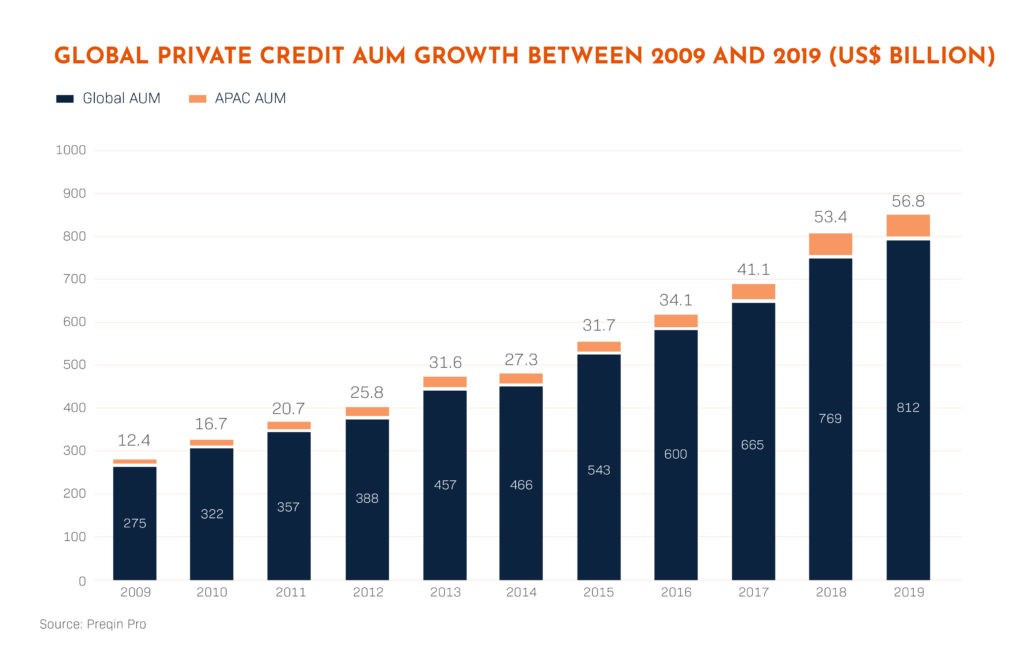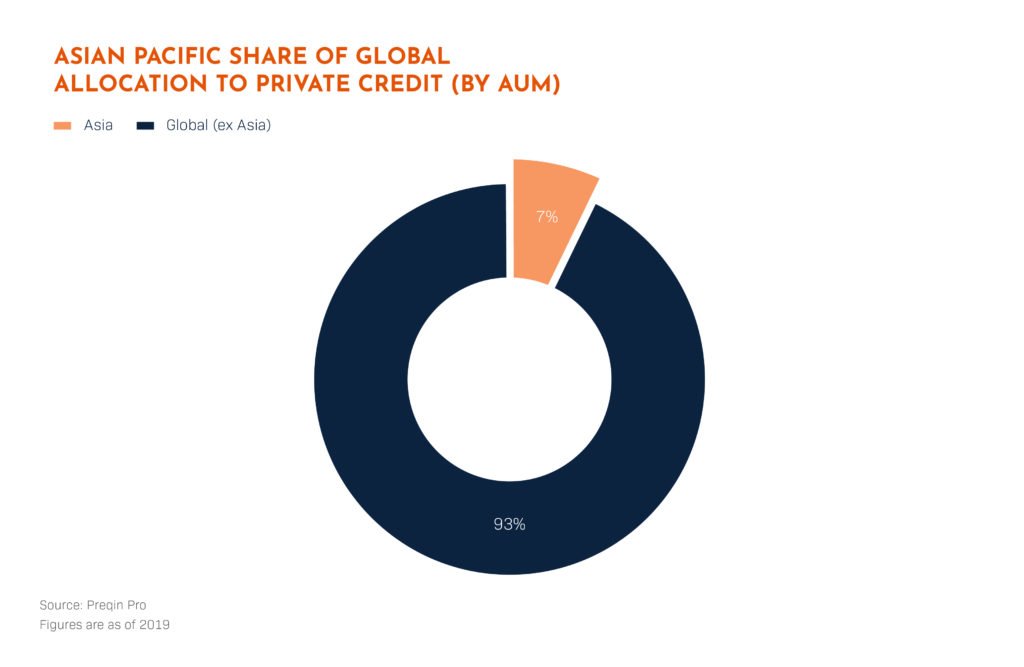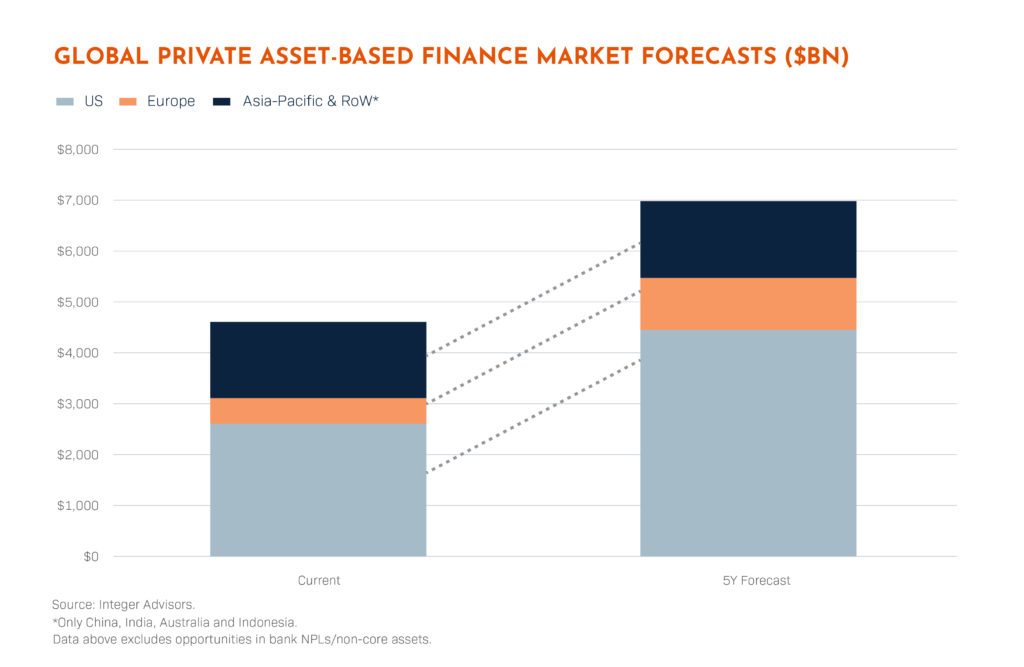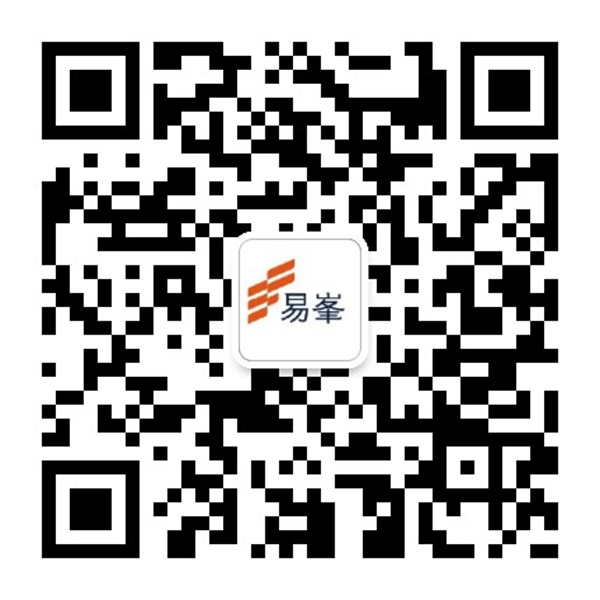Keeping private credit on a sustainable growth path
As a committed specialist in this space, we’re confident it will play an integral role in helping individuals, businesses and entire economies weather the impacts of the pandemic, and pursue the opportunities that will come with recovery. Here are the main reasons why.
Bridging a gap
The first is the retrenchment of banks from the lending market since the 2007-2008 financial crisis, a trend that the pandemic looks set to accelerate[1] With small and mid-market firms in particular struggling to access financing from traditional sources, private credit assets under management (AUM) globally surged from US$275 billion in 2009 to over US$800 billion in 2019.[2] The Alternative Credit Council has forecast the total could hit US$1 trillion this year.[3]
With this growth has come recognition that private credit is not a niche concern, but an essential element of the global financing landscape. Around a third of committed capital goes to small and medium-sized companies. These are the lifeblood of most economies, accounting for 90 percent of businesses and 50 percent of employment worldwide.[4]

Another reason for optimism is that private credit still has plenty of room to expand, particularly in Asia. While private credit AUM in Asia doubled from 2014 to last year, such assets still represent a mere sliver of AUM worldwide, a proportion vastly out of kilter with the region’s role in global economic growth.[5]

Research also points to significant untapped demand among Asian borrowers. One recent poll by Acuris found 68% of mid-market firms in the region viewed financing from non-traditional lenders as critical to their business, and that 82% planned to seek such financing in the year ahead.[6]
A flexible funding source
This appetite brings us to the third major success factor for private credit: its inherent flexibility. As Acuris points out, traditional lenders contend with bureaucratic processes and are typically confined to providing loans in defined formats and under certain conditions. Such arrangements are not always optimal for enterprises or entrepreneurs with distinct business models or funding requirements.
While any reputable provider of private credit must also be mindful of regulation and a borrower’s risk profile, in general non-bank lenders are able to disburse capital more efficiently and have more room for maneuver to meet borrower needs.
Private credit also benefits from its diversity. It is a vast space spanning strategies from mezzanine financing to direct lending, each offering its own means to manage risks and mobilize capital. This means funding can be generated in all kinds of market conditions, and that there are options for virtually all would-be borrowers and investors.
Our area of expertise, private asset-based finance, alone is a US$4.5 trillion market globally, forecast to rise to US$6.9 trillion over the next five years, according to KKR.[7]

As traditional lenders face even more constraints in the wake of COVID-19, asset-backed lending is expected to become a ‘go-to’ source of credit. Like other types of private credit, it is versatile, since virtually any asset, from real estate to aircraft, even contracts, can serve as a basis for funding.
Though loans need to be structured carefully, in general risks are limited by the lender’s ability to recover this collateral, and by the increasingly sophisticated, technology-based processes being applied to deal origination, underwriting and risk management.
Bright prospects for equity-backed lending
Drilling down further within asset-based finance, we see equity-backed lending emerging as a prominent funding source as it ticks so many boxes for both lenders and borrowers.
Equity markets have proven to be massive engines of value in recent years and the untapped potential being unlocked in emerging markets shows this is set to continue. Particularly in Asia’s dynamic economies, a rising middle class, growing ranks of entrepreneurs and vigorous listing activity will all help expand the pool of stock owners.

Flourishing businesses and wealth will fuel demand for funding to drive the next stage of growth, or meet personal ambitions. Equity-backed lending is ideally situated to meet this demand, as unlike margin lending it is typically non-purpose. That means the borrower is free to deploy the capital however they see fit. Equity-backed loans are also generally non-recourse, meaning the borrower’s liability is limited to the collateral.
Furthermore, equity-backed loans offer the borrower an opportunity to tap into the value of their investments without sacrificing the potential for market appreciation. Once a loan is repaid, the securities used as collateral are returned in full. If they have appreciated during the term of the loan, the borrower is still in a position to benefit. Meanwhile, having a relatively liquid asset as collateral allows the lender to offer highly competitive terms and rates, and to gain from temporarily adding the stock to their own portfolio.
Equity-backed lending is therefore arguably unmatched in its ability to serve both lender and borrower interests. Our faith in the model and its potential is the reason we have chosen to focus exclusively on this space, and worked to perfect our approach to it over the last two decades.
While we see significant potential for near-term growth in asset-backed lending, we are also conscious that, like the rest of private credit, it cannot simply grow; it needs to do so sustainably.
This is why in addition to bringing our solutions to more borrowers, and extending our capabilities to areas like digital assets,[8] we are investing heavily in building local networks, and forging close relationships with regulators and institutional partners.
Demonstrating commitment, and working closely with other stakeholders to enhance the range of funding options available without compromising standards or governance, is key to ensuring private credit is no longer viewed as an ‘alternative’ form of lending, but as a vital and vibrant part of the spectrum of solutions channeling capital where it is needed to fund future prosperity.
[1] www.allianzgi.com/en/insights/investment-themes-and-strategy/private-lending-post-covid-19
[2] www.simmons-simmons.com/en/publications/ckecj9sk3182c09430t4lsd0i/private-credit-in-asia-report
[3] www.aima.org/article/acc-sees-private-credit-market-reaching-1-trillion-by-2020.html
[4] www.worldbank.org/en/topic/smefinance
[5] www.simmons-simmons.com/en/publications/ckecj9sk3182c09430t4lsd0i/private-credit-in-asia-report
[6] www.acuris.com/asian_mid-market_direct_lending_report
[7] www.kkr.com/sites/default/files/Asset_Based_Finance_Q2_2020.pdf
[8] osl.com/en/in-the-news/press-releases/20200616efhpressrelease
ข้อจำกัดความรับผิดชอบ
ผลการดำเนินงานในอดีตมิได้รับประกันผลตอบแทนในอนาคต และไม่มีการรับประกันหรือรับรองผลตอบแทนของแต่ละบุคคล
เอกสารฉบับนี้จัดทำขึ้นสำหรับนักลงทุนที่ได้รับการรับรอง นักลงทุนที่มีความเชี่ยวชาญ นักลงทุนมืออาชีพ หรือนักลงทุนที่มีคุณสมบัติตามที่กฎหมายอื่น ๆ กำหนดเท่านั้น และไม่ได้จัดทำขึ้นสำหรับและไม่ควรใช้โดยบุคคลที่มีลักษณะไม่เป็นไปตามข้อกำหนดที่เกี่ยวข้อง เนื้อหาที่ระบุไว้ในเอกสารฉบับนี้มีวัตถุประสงค์เพื่อให้ข้อมูลเท่านั้น อีกทั้งยังเป็นเนื้อหาที่มีลักษณะทั่วไปและไม่ได้จัดทำขึ้นเพื่อวัตถุประสงค์หรือความต้องการทางการเงินที่เฉพาะเจาะจงใด ๆ มุมมองและความคิดเห็นที่ปรากฏในเอกสารฉบับนี้ได้จัดทำขึ้นโดยบุคคลที่ภายนอก และอาจไม่ได้สะท้อนมุมมองและความคิดเห็นของ EquitiesFirst นอกจากนี้ EquitiesFirst ไม่ได้ตรวจสอบหรือยืนยันข้อมูลที่ระบุไว้ในเอกสารฉบับนี้ด้วยตนเอง และไม่ได้รับรองว่าข้อมูลดังกล่าวถูกต้องหรือสมบูรณ์ ความคิดเห็นและข้อมูลในเอกสารฉบับนี้อาจมีการเปลี่ยนแปลงโดยไม่ต้องแจ้งให้ทราบล่วงหน้า เนื้อหาที่ระบุไว้ในเอกสารฉบับนี้ไม่ถือเป็นการเสนอขาย (หรือการชักชวนให้ซื้อ) หลักทรัพย์ การลงทุน หรือผลิตภัณฑ์ทางการเงินใด ๆ (“ข้อเสนอ”) ข้อเสนอใด ๆ ดังกล่าวจะต้องดำเนินการผ่านการเสนอขายที่เกี่ยวข้องหรือเอกสารอื่น ๆ ที่มีการระบุข้อกำหนดและเงื่อนไขที่เป็นสาระสำคัญไว้อย่างชัดเจนเท่านั้น ข้อมูลใด ๆ ในเอกสารฉบับนี้ไม่ถือเป็นการแนะนำ การจูงใจ การเชิญชวน การโน้มน้าว การส่งเสริมการขาย หรือเป็นข้อเสนอให้ซื้อหรือขายผลิตภัณฑ์การลงทุนใด ๆ จาก Equities First Holdings, LLC หรือบริษัทย่อยของ Equities First Holdings, LLC (เรียกรวมกันว่า ” EquitiesFirst”) และไม่ควรตีความในทางใดทางหนึ่งว่าเอกสารฉบับนี้เป็นการแนะนำด้านการลงทุน กฎหมาย หรือภาษี รวมถึงการแนะนำ การอ้างอิง หรือการรับรองจาก EquitiesFirst ท่านควรเสาะหาคำแนะนำทางการเงินด้วยตนเองก่อนตัดสินใจลงทุนในผลิตภัณฑ์ทางการเงิน
เอกสารฉบับนี้ประกอบด้วยทรัพย์สินทางปัญญาของ EquitiesFirst ในสหรัฐอเมริกาและประเทศอื่น ๆ รวมถึงแต่ไม่จำกัดเพียงโลโก้ต่าง ๆ และเครื่องหมายการค้าอื่น ๆ ทั้งที่จดทะเบียนและไม่ได้จดทะเบียน ตลอดจนเครื่องหมายบริการที่เกี่ยวข้องตามลำดับ EquitiesFirst ขอสงวนสิทธิ์ทั้งหมดในทรัพย์สินทางปัญญาที่ปรากฏในเอกสารฉบับนี้ เอกสารฉบับนี้ไม่ควรนำไปแจกจ่าย เผยแพร่ ทำซ้ำ หรือดำเนินการด้วยวิธีอื่น ๆ ที่ทำให้ผู้รับสามารถส่งต่อเนื้อหาทั้งหมดหรือบางส่วนของเอกสารฉบับนี้ไปยังผู้อื่นได้ โดยเฉพาะอย่างยิ่ง เอกสารฉบับนี้ไม่ควรนำไปแจกจ่ายให้แก่บุคคลในประเทศใด ๆ ซึ่งอาจนำไปสู่การละเมิดกฎหมายหรือระเบียบอื่นใดที่เกี่ยวข้อง
EquitiesFirst ไม่รับรองหรือรับประกันใด ๆ เกี่ยวกับเอกสารฉบับนี้ และขอปฏิเสธอย่างชัดแจ้งต่อการรับประกันโดยนัยใด ๆ ภายใต้กฎหมาย ท่านรับทราบว่า EquitiesFirst จะไม่ต้องรับผิดในทุกกรณี สำหรับความเสียหายทั้งทางตรง ทางอ้อม ที่เป็นกรณีพิเศษ ที่เป็นผลสืบเนื่อง โดยไม่เจตนา หรือที่เป็นการลงโทษ รวมถึงแต่ไม่จำกัดเพียงการสูญเสียผลประโยชน์หรือการสูญเสียโอกาสใด ๆ แม้ว่า EquitiesFirst จะรับทราบถึงความเป็นไปได้ของความเสียหายดังกล่าวก็ตาม
EquitiesFirst ได้จัดทำคำแถลงการเพิ่มเติมดังต่อไปนี้ ซึ่งอาจบังคับใช้ในเขตอำนาจศาลที่ระบุไว้
ประเทศออสเตรเลีย: Equities First Holdings (Australia) Pty Ltd (หมายเลขทะเบียนบริษัท: 142 644 399) เป็นผู้ได้รับใบอนุญาตบริการทางการเงินของประเทศออสเตรเลีย (หมายเลข AFSL: 387079) สงวนลิขสิทธิ์ทั้งหมด
ข้อมูลที่ปรากฏในเอกสารฉบับนี้มีไว้สำหรับบุคคลที่อาศัยอยู่ในประเทศออสเตรเลียและจัดเป็นลูกค้าสำหรับการค้าส่ง (Wholesale Client) ตามที่ระบุในมาตรา 761G แห่งพระราชบัญญัติบริษัท ค.ศ. 2001 (Corporations Act 2001)เท่านั้นการเผยแพร่ข้อมูลให้บุคคลอื่นใดที่มีคุณสมบัติไม่เป็นไปตามเกณฑ์ที่กำหนดข้างต้นอาจมีข้อจำกัดตามกฎหมาย ทั้งนี้ บุคคลใดที่มีข้อมูลดังกล่าวในครอบครองควรเสาะหาคำแนะนำและทำความเข้าใจข้อจำกัดดังกล่าว เนื้อหาที่ปรากฏในเอกสารฉบับนี้มีวัตถุประสงค์เพื่อให้ข้อมูลเท่านั้น และไม่ควรตีความว่าข้อมูลดังกล่าวเป็นข้อเสนอ การจูงใจ หรือคำแนะนำในการซื้อหรือขายผลิตภัณฑ์ทางการเงิน ข้อมูลที่ปรากฏในเอกสารฉบับนี้มีวัตถุประสงค์เพื่อให้ข้อมูลในลักษณะทั่วไป และไม่ใช่คำแนะนำเกี่ยวกับผลิตภัณฑ์ทางการเงินส่วนบุคคล คำแนะนำใด ๆ ที่ปรากฏในเอกสารฉบับนี้เป็นคำแนะนำทั่วไปเท่านั้น และจัดทำขึ้นโดยไม่ได้คำนึงถึงวัตถุประสงค์ สถานการณ์หรือความต้องการทางการเงินของผู้ลงทุน ก่อนดำเนินการเกี่ยวกับข้อมูลใด ๆ ที่ปรากฏในเอกสารฉบับนี้ ท่านควรพิจารณาถึงความเหมาะสมของข้อมูลดังกล่าว และลักษณะของผลิตภัณฑ์ทางการเงินที่เกี่ยวข้อง โดยคำนึงถึงวัตถุประสงค์ สถานการณ์ และความต้องการทางการเงินของท่านท่านควรเสาะหาคำแนะนำทางการเงินด้วยตนเอง และอ่านคำแถลงการเกี่ยวกับการเปิดเผยข้อมูลที่เกี่ยวข้อง หรือเอกสารข้อเสนออื่น ๆ ก่อนตัดสินใจลงทุนในผลิตภัณฑ์ทางการเงิน
ดูไบ: Equities First Holdings Hong Kong Ltd (สำนักงานตัวแทน DIFC) ตั้งอยู่ที่ Gate Precinct Building 4, 6th Floor, Office 7, Dubai International Financial Centre (เลขทะเบียนพาณิชย์ CL7354) อยู่ภายใต้การกำกับดูแลของ Dubai Financial Services Authority (“DFSA”) ในฐานะสำนักงานตัวแทน (เลขที่อ้างอิงบริษัทของ DFSA: F008752) สงวนลิขสิทธิ์ ข้อมูลที่รวมอยู่ในเอกสารฉบับนี้จัดทำขึ้นเพื่อการใช้งานโดยทั่วไป หากมีเนื้อหาส่วนใดที่อาจเข้าใจว่าเป็นคำแนะนำ ให้ถือว่าคำแนะนำใดที่รวมอยู่ในเอกสารฉบับนี้เป็นเพียงคำแนะนำโดยทั่วไป ไม่ได้จัดทำขึ้นโดยพิจารณาถึงวัตถุประสงค์ สถานการณ์ทางการเงิน ความเหมาะสมของผลิตภัณฑ์ทางการเงิน หรือตามความต้องการของคุณ
เนื้อหาสาระที่รวมอยู่ในเอกสารฉบับนี้มีวัตถุประสงค์เพียงเพื่อการให้ข้อมูลเท่านั้น และไม่ควรถือเป็นการให้คำแนะนำทางการเงิน อีกทั้งไม่ถือเป็นการเสนอหรือเชิญชวนหรือแนะนำให้ซื้อหรือขายผลิตภัณฑ์ทางการเงินแต่อย่างใด ข้อมูลที่รวมอยู่ในเอกสารฉบับนี้จัดทำขึ้นเพื่อการใช้งานโดยทั่วไป คำแนะนำใดที่รวมอยู่ในเอกสารฉบับนี้เป็นเพียงคำแนะนำโดยทั่วไป ไม่ได้จัดทำขึ้นโดยพิจารณาถึงวัตถุประสงค์ สถานการณ์ทางการเงิน ความเหมาะสมของผลิตภัณฑ์ทางการเงิน หรือตามความต้องการของคุณ ดังนั้นก่อนดำเนินการตามข้อมูลเหล่านี้ คุณควรพิจารณาถึงความเหมาะสมของข้อมูลที่ให้ไว้ ตลอดจนลักษณะของผลิตภัณฑ์ทางการเงินที่เกี่ยวข้องตามวัตถุประสงค์ สถานการณ์ทางการเงิน และความต้องการของคุณ หากคุณไม่เข้าใจเนื้อหาในเอกสารฉบับนี้ โปรดขอคำปรึกษาจากที่ปรึกษาทางการเงินที่ได้รับอนุญาต
เอกสารฉบับนี้เกี่ยวข้องกับผลิตภัณฑ์ทางการเงินซึ่งไม่อยู่ภายใต้ข้อบังคับใดหรือไม่จำเป็นต้องได้รับอนุมัติจาก DFSA และ DFSA ไม่มีหน้าที่ในการตรวจสอบหรือยืนยันเอกสารใดอันเกี่ยวข้องกับผลิตภัณฑ์ทางการเงินนี้ อีกทั้ง DFSA ไม่ได้เป็นผู้อนุมัติเอกสารฉบับนี้หรือเอกสารอื่นใดที่เกี่ยวข้อง รวมถึงไม่ได้ดำเนินมาตรการใดเพื่อยืนยันความถูกต้องของข้อมูลที่ปรากฏในเอกสารฉบับนี้ และไม่รับผิดชอบต่อข้อมูลดังกล่าว
เขตบริหารพิเศษฮ่องกง: Equities First Holdings Hong Kong Limitedได้รับใบอนุญาตภายใต้กฎหมายผู้ให้กู้ยืมในฮ่องกง (หมายเลขใบอนุญาตผู้ให้กู้เลขที่ 1659/2024)และดำเนินธุรกิจด้านการจัดการกับหลักทรัพย์ (ใบอนุญาตประเภทที่ 1)ภายใต้กฎหมายการกำกับหลักทรัพย์และสัญญาซื้อขายล่วงหน้าของฮ่องกง (“SFO”) (หมายเลข CEเลขที่ BFJ407)เอกสารฉบับนี้ยังไม่ได้รับการตรวจสอบจากคณะกรรมการกำกับหลักทรัพย์และสัญญาซื้อขายล่วงหน้าของฮ่องกงนอกจากนี้เอกสารฉบับนี้ไม่ได้จัดทำขึ้นเพื่อเป็นเสนอการขายหลักทรัพย์ หรือชักจูงให้ซื้อผลิตภัณฑ์ที่จัดการหรือจัดหาโดย Equities First Holdings Hong Kong Limitedแต่จัดทำขึ้นสำหรับบุคคลที่มีคุณสมบัติเป็นนักลงทุนมืออาชีพภายใต้ SFOเท่านั้นเอกสารฉบับนี้ไม่ได้ส่งถึงบุคคลหรือองค์กรที่จะทำให้ข้อเสนอหรือคำเชิญชวนดังกล่าวผิดกฎหมายหรือถูกต้องห้าม
ประเทศเกาหลี: เอกสารข้างต้นจัดทำขึ้นสำหรับนักลงทุนรายใหญ่ที่มีความเชี่ยวชาญ นักลงทุนมืออาชีพ หรือนักลงทุนที่มีคุณสมบัติเหมาะสม ซึ่งมีความรู้และประสบการณ์เพียงพอต่อการทำธุรกรรมการจัดหาเงินทุนหลักทรัพย์เป็นการเฉพาะเจาะจง และไม่ได้จัดทำขึ้นสำหรับและไม่ควรใช้โดยบุคคลที่มีลักษณะไม่ตรงตามข้อกำหนดข้างต้น
สหราชอาณาจักร: Equities First (London) Limited ได้รับการรับรองและควบคุมในสหราชอาณาจักรโดยหน่วยงานกำกับดูแลด้านการเงิน (” FCA”) ในสหราชอาณาจักร เอกสารฉบับนี้ได้แจกจ่ายให้แก่บุคคลที่มีลักษณะเป็นไปตามมาตรา 19(5) (นักลงทุนมืออาชีพ) และมาตรา 42(2) (บริษัทที่มีมูลค่าสุทธิสูง สมาคมอิสระ ฯลฯ) ในส่วนที่ 4 ของพระราชบัญญัติว่าด้วยเรื่องบริการทางการเงินและตลาด ค.ศ. 2000 (การสนับสนุนทางการเงิน) คำสั่ง ค.ศ. 2005 (“FPO”) เท่านั้น และกิจกรรมการลงทุนใด ๆ ที่เกี่ยวข้องกับการนำเสนอนี้จะใช้ได้เฉพาะกับบุคคลดังกล่าวและมีเพียงแค่บุคคลดังกล่าวเท่านั้นที่จะสามารถมีส่วนร่วมในกิจกรรมดังกล่าวได้ บุคคลที่ไม่มีประสบการณ์ระดับมืออาชีพในการลงทุน หรือบุคคลที่มีลักษณะไม่เป็นไปตามมาตรา 49 ของ FPO ไม่ควรใช้เอกสารนี้ เอกสารฉบับนี้จัดทำขึ้นสำหรับบุคคลที่มีคุณสมบัติเป็นนักลงทุนมืออาชีพภายใต้หน่วยงานที่ให้การกำกับการให้บริการด้านการลงทุนและผลิตภัณฑ์ทางการเงินในพื้นที่ภาคพื้นยุโรป (MiFID) เท่านั้น
